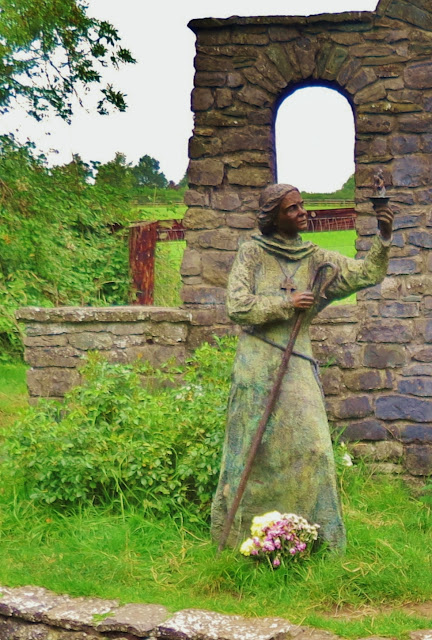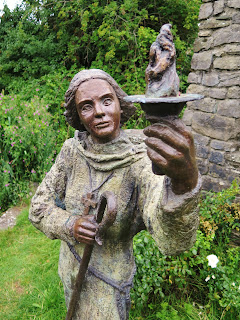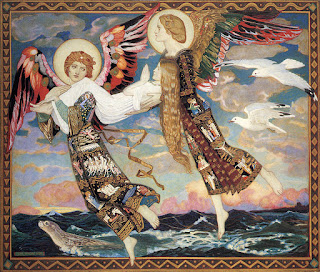Long before Brigid was the Patron saint of Ireland, there was a Goddess Bríde who was venerated all over the Celtic world. At St. Brigid's well, you feel Ireland's ancient past wrapped around you like a mantle...

Holy wells in Ireland are plentiful. Over 3,000 wells and springs dot the countryside; more than any other country in the world. Always dedicated to an Irish Saint, in ancient times these sacred wells, were places of power devoted to Celtic Gods and Goddesses. In myth and folktale, sacred springs are portals to the Otherworld, the realm of the unseen...the realm of the faeries. The holy wells were visited at the four significant Pre-Christian holy days February 1 (Imbolc), May 1 (Beltaine), August 1 (Lughnasadh) and November 1 (Samhain). Other times a well would be visited was when someone needed healing, poetic inspiration, or trying to conceive a child. These wells and sacred pools often had fish in them which were said to have magical powers, for they lived in the waters that have healing and transformative power.
 |
| St. Brigid's Slippers |
Many of the sacred springs and wells in Ireland have elements of pre-Christian ritual sites. Accompanying the well or natural spring, there was often a standing stone, a natural or man-made hill, and a very ancient tree; oftentimes a Hazelnut or Ash tree. There was usually a ritual circuit for each sacred site. Often the ritual included circling the well a certain number of times in a clockwise direction, then drinking or bathing in the spring water. The ceremony concluded with leaving an offering for the God, Goddess or Spirit of the well in gratitude.
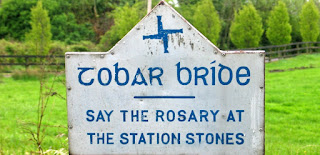 |
| "Tobar Bride" is Irish for Brigid's Well |
When Christianity came to Ireland in the 5th century, Christian churches were often built at the pilgrim site of the holy wells, using the water of the well as a baptismal font. There are even some churches built directly over pagan wells that still have a subterranean spring in its crypt!
As the new Christian stone churches were being built, gathering at the holy well sights either fell out of popularity or was forbidden. After the Dissolution of the Monasteries in the mid-1500s, many Roman-Catholics had nowhere to worship once their Church was disbanded or destroyed. Catholic parishioners then decided to gather once again at the holy well sights on the Parish's Patron Saint's Feast Day. The word 'Patron' turned into 'Pattern' and visiting Holy Wells on 'Pattern Day' became very popular in Irish culture in the 1700s.
 |
| The Spring & The Stones Leading to The Well |

I visited Kildare's "Tobar Bríde" or Saint Brigid's well. In Irish, Tobar means well, and Bríde is one of the spellings for the Celtic Goddess Brigid. Kildare or Cill Dara is Irish for "Church of the Oak," and it is in Kildare that St. Brigid established her monastery in the 5th century. Check out my blog post on Saint Brigid for more information on this fascinating woman that helped shape the history of Ireland.

Kildare is about a 45-minute drive from Dublin on the M7 motorway. While St. Brigid's Cathedral is located in the heart of Kildare, the well is located on the Southside of the M7 in a park-like setting. From Dublin heading East on the M7 take the Kildare Centre exit and head South on the R415 following the directions to the Irish National Stud. Take the second left, and you will see a sign to the well on a small laneway to the right. There is parking for a few cars at the entrance gate to the park.
 |
| Cloutie Tree To The Left of The Well |
I had learned about St. Brigid's well from some women in my spiritual community back home in Vancouver, Canada, In fact, while I was visiting the well in Kildare, an Irish-Canadian woman was gathering water to bring back to her home in Toronto. The woman was a Catholic, and she explained that she believed the waters from this well helped to heal her from her cancer.
The well is in a small park maintained by the Brigidine Sisters. The deep well with a stone cross is fed by an underground spring. The water then travels in an underground stream and path is marked by "station stones" where one would say prayers at each stone. Then the flow pops to the surface again at a stone archway leading to a stepped channel. The two U-shaped stones under the arch are called St. Brigid's Slippers and are flumes to divert the flow when the water is running high. Tradition has it that this area was used for early Christian baptisms and healing rituals.
 |
| St Brigid by Annette McCormack |
Behind the well is a traditional clootie tree. A "clootie" or "cloutie" is a strip of cloth or leather. The cloutie strip is dipped into the well or spring and then used to wash the affected area of the body. The cloutie is then tied to a sacred tree next to the well, and as the cloth turns to rags and disintegrates, the illness will disappear.
Another tradition of sacred wells is the spotting of a tiny fish in the well. Of course, the symbol of the fish was an early symbol for Christianity before the cross. If you peer into the well at Tobar Bride, you may spot a little fish frolicking in the spring. A sighting of the fish is supposed to ensure that St. Brigid has answered your prayers.
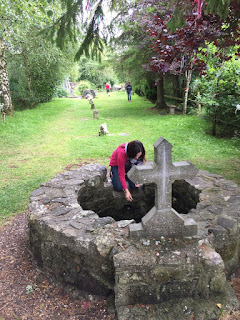
I am happy to report there was a goldfish sighting in the dark waters of Tobar Bride in August of 2018. Let me tell you my prayers were answered swiftly and directly! The transformative energy of Brigid was not a slow burn, but a raging inferno that has changed the course of my life forever.
I hope you have the opportunity to add one of Ireland's magical holy wells to your Irish itinerary.
For another of my blog posts on Ancient Sacred Sites in Ireland click HERE
For another of my blog posts on Ancient Sacred Sites in Ireland click HERE


